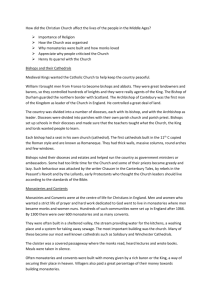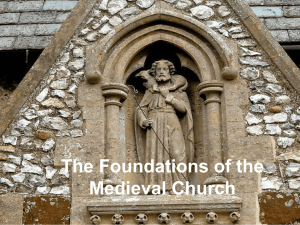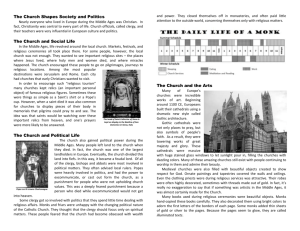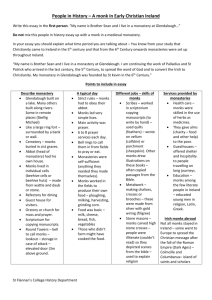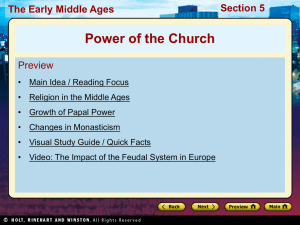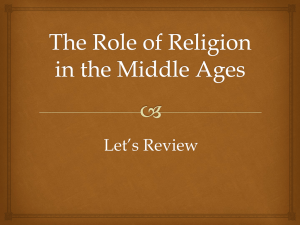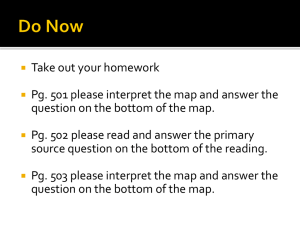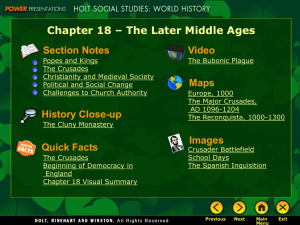Article Notes The Church: One of the most important of all institutions
advertisement
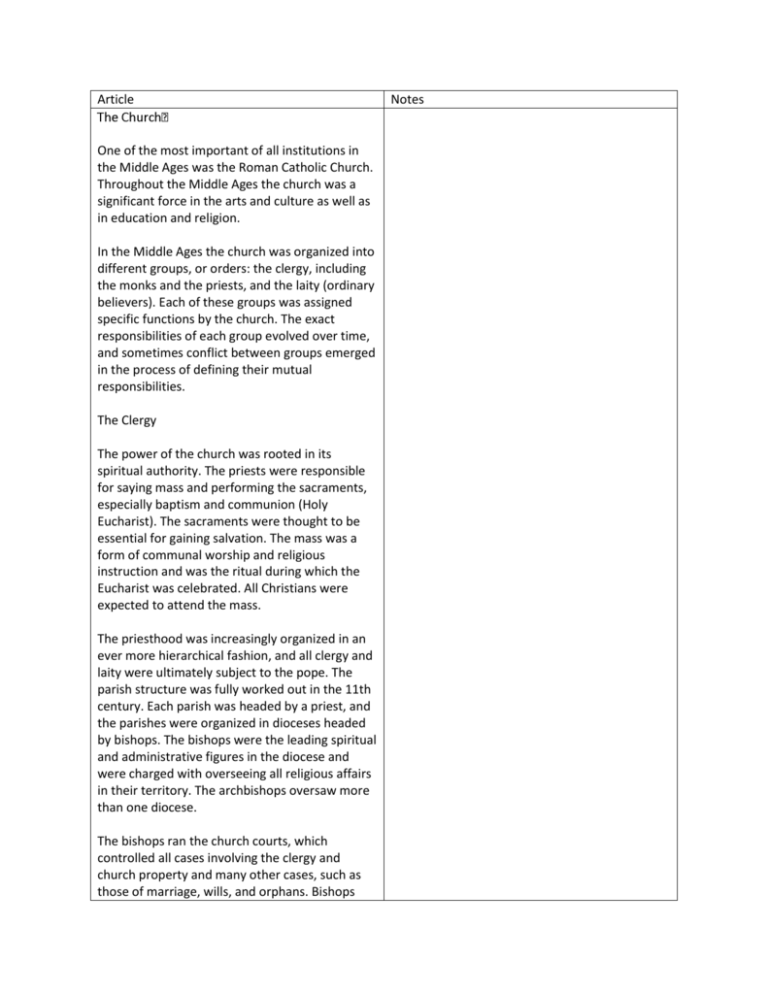
Article One of the most important of all institutions in the Middle Ages was the Roman Catholic Church. Throughout the Middle Ages the church was a significant force in the arts and culture as well as in education and religion. In the Middle Ages the church was organized into different groups, or orders: the clergy, including the monks and the priests, and the laity (ordinary believers). Each of these groups was assigned specific functions by the church. The exact responsibilities of each group evolved over time, and sometimes conflict between groups emerged in the process of defining their mutual responsibilities. The Clergy The power of the church was rooted in its spiritual authority. The priests were responsible for saying mass and performing the sacraments, especially baptism and communion (Holy Eucharist). The sacraments were thought to be essential for gaining salvation. The mass was a form of communal worship and religious instruction and was the ritual during which the Eucharist was celebrated. All Christians were expected to attend the mass. The priesthood was increasingly organized in an ever more hierarchical fashion, and all clergy and laity were ultimately subject to the pope. The parish structure was fully worked out in the 11th century. Each parish was headed by a priest, and the parishes were organized in dioceses headed by bishops. The bishops were the leading spiritual and administrative figures in the diocese and were charged with overseeing all religious affairs in their territory. The archbishops oversaw more than one diocese. The bishops ran the church courts, which controlled all cases involving the clergy and church property and many other cases, such as those of marriage, wills, and orphans. Bishops Notes also exercised the power of excommunication. This excluded those guilty of serious crimes against the church from participating in church services or receiving the sacraments, and other Christians were forbidden from associating with them. Excommunication was intended not as a punishment but as a tool to encourage proper Christian behavior. At the very top of the organization of the church was the pope. Before the 11th century, the authority of the pope was limited. He was understood to be the most important of the bishops in the Roman Catholic Church, but he was not always seen as the ruler of the church. He could claim special status as the successor of the apostle St. Peter—Catholics believe that St. Peter was the first bishop of Rome and that all popes are his heirs. Some popes of the early Middle Ages, such as Gregory I, the Great (590– 604), were effective rulers who imposed their will on all of the church. Others exercised more limited powers. In the 11th century a series of popes, including Gregory VII (1073–85), transformed the church into a highly structured organization headed by the pope. Popes after the 11th century ruled almost as kings. They exercised authority over questions of religious faith and practice, intervened in political affairs, and were the superiors of all bishops and other clergy. The church kept alive the spark of public education. True, in the lords’ castles pages went to their lessons, but pages were extremely few compared with the number of peasant boys. For them, the church looked to each village parish to supply a school and religious training. Each diocese was expected to maintain a cathedral school to educate the clergy. The work of the church was supported by the work of monks and nuns, who retired from worldly distractions to live in monasteries and convents. They gave up earthly pleasures to prepare for salvation. For that, they accepted a life of prayer and labor and upheld the Christian precept of “Love thy neighbor as thyself.” Their example was bulwarked starting in the 13th century by the work of the friars, men of religious orders who went into the world to preach to the people of the growing towns and cities. The most important and influential guideline for monastic life was the strict yet wholesome and practical Rule of Benedict of Nursia (480?–547?). The Benedictine Rule put upon the monks the double duty of prayer and work. Benedict sought to establish a balance in the daily life of his monks so that they did not indulge themselves in any one practice. The monks had to do some manual labor, such as clearing forests, draining swamps, nursing the sick, sheltering travelers, and serving the needy. In this way, the monks provided important services to society in addition to their spiritual duties. In the Middle Ages, though, it was their prayer that was most valued, and many people made donations to the monasteries so that the monks would pray for them. Of the contributions made by the monks’ manual labor, two were especially notable. The first directly helped people of the Middle Ages: it was farming skill. Monasteries were traditionally established in the countryside, and the monks were successful farmers. One group of monks, the Cistercians, have been called the best farmers of medieval days. They founded new monasteries far away from the towns and other population centers and brought more land into cultivation. The monks’ second special service was producing manuscripts. Even before the downfall of Rome the church had begun to preserve the books of Roman and Greek knowledge. Neither the siege nor the sack of Rome found the church surrendering its full treasury of classical learning. Later, when the church came to power, monks spent hours in the scriptorium, or writing room. There they meticulously copied the scrolls, letter by letter. One monk wrote at the end of a manuscript: “He who does not know how to write imagines that it is no labor; but, though only three fingers hold the pen, the whole body grows weary.” Their labors preserved not only classical knowledge but also the works of Christian thinkers. Monks copied the books of the Bible, the writings of the Church fathers, and other works of theology and doctrine. The monks also wrote works of history, theology, poetry, law, and other disciplines. The Laity During the Middle Ages, the church played an ever-increasing role in the daily life of the laity, especially after the Gregorian Reform movement of the 11th century. The church assumed responsibility for guiding Christians from birth to death and presided over important rites of passage throughout their lives. All Christians were expected to receive baptism as infants. This rite not only introduced the child into the community of the faithful but also strengthened relations within the earthly community. An important element of the baptismal rite was the identification of godparents who were bound to the newly baptized child and responsible for ensuring the child’s growth as a Christian. The church also required that all Christians offer confession of sins to a priest and receive the sacrament of the Eucharist at least once a year. Medieval Christians turned to the church to confirm the rite of marriage as well. Originally, the priestly blessing of marriages (and even the marital bed) took place outside the church. During the 11th and 12th centuries, however, the church defined marriage as one of the seven sacraments, and marriages were then consecrated inside churches. The church also declared that only those outside set limits of blood relation could marry, a rule that proved difficult to follow at the village level, where people tended to be fairly closely related. At life’s end, the church (a priest) would administer last rites and offer burial in the church’s graveyard. The powerful sometimes made donations to churches or monasteries to secure burial in consecrated ground there. The religious calendar directly affected all Christians throughout the Middle Ages as they celebrated the holy feasts of the year. Christmas and Easter were great holy days of celebration and solemnity. Christians honored a series of fasts as well, notably in the 40 days before Easter (Lent), during which time they abstained from eating certain foods. They also celebrated saints’ days, which were cause for processions, masses, and feasting. The saints, or the holy dead, and their relics— that is, their mortal remains or objects the saints had touched—were central facets in the religious life of the Middle Ages. Saints’ relics were collected and were venerated as the locus of the saints’ holy power on earth. The relics were thought to effect cures of the sick, lame, and blind and to cause other miracles, including the rescue of those unfairly imprisoned. The Holy Eucharist too was thought to effect miracles and was sometimes sown in peasants’ fields to secure a better harvest. "Middle Ages." Britannica School. Encyclopædia Britannica, Inc., 2014. Web. 16 Oct. 2014. <http://school.eb.com/levels/middle/article/275833#>.

